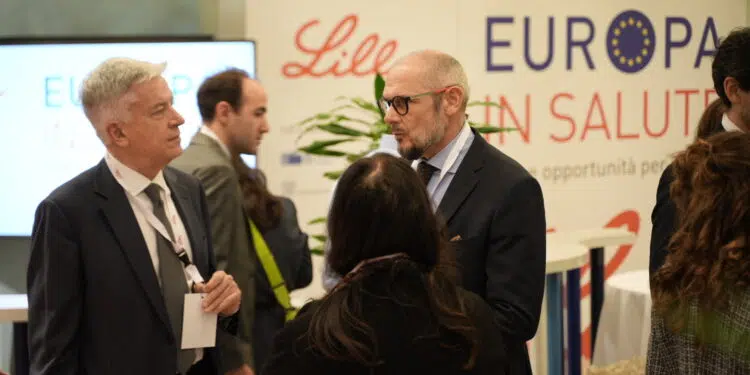Rome – The dates marked in red are next June 8 and 9. The European elections will take place in a very particular historical phase, in the aftermath of a global pandemic and amid two transitions, ecological and digital, that still need many details to fall into place. To take stock of the situation, Ely Lilly organized on Wednesday, March 6, at the Spazio Europa in Rome (a building that now also houses the company’s new offices) a broad discussion among parliamentarians, pharmaceutical experts, and government, with the conference entitled “Europe in Health. Challenges and Opportunities for the Future“. The summary reflects the tone of the debate that animates current events: we need economic, social, and environmental sustainability to ensure pharmaceutical safety, but also the right match between the public strength and the private sector’s know-how. And above all, innovation.
Therefore, In this scenario, the work of national institutions, especially European ones, appears fundamental. “If we apply restrictive regulations, we are off the market,” warns the undersecretary for Health, Marcello Gemmato. Recalling that “the pharmaceutical industry has a turnover of €50 billion”, our country is among the first places in the EU, contending (often) for leadership with Germany. “We’re talking about GDP, research, employment,” Gemmato stressed. “It’s clear that this is a value to be defended, along with that of research, and for this, the government has spoken out much more stringently than before in Europe.
After all, we are talking about health, an issue that concerns all citizens of the Old Continent: “A priority for the European Parliament,” says Fabrizio Spada, the EU Parliament’s head of relations in Italy. Adding that it is also “an investment: with a budget of €5.3 billion over the 2021-2027 period, the Eu4Health program represents unprecedented financial support in the health sector.”
It is precisely on the Pharmaceutical Strategy for Europe that an important part of the discussion is focused. Indeed, the reform adopted in 2020 by the European Commission, now under consideration by the EU Parliament and Council for simplifying regulations and promoting accessible and timely innovation, attracts general attention. Companies, too, of course. Especially to calibrate their investments, such as Ely Lilly for example, which a few months ago announced plans to build a new 2.5 billion high-tech manufacturing site in Germany and, recently, a further investment in Italy of more than €750 million over the next two years to boost the production of innovative drugs. “It is critical to welcome innovation through a single strategy that combines industrial policy for growth and recognizes the value of therapies to the European economy and, most importantly, to its citizens,” explains Lilly International President Ilya Yuffa. “To achieve this goal, we call for pragmatic policies and solutions that facilitate timely access to innovative medicines for patients across Europe, improving clinical outcomes and ensuring the sustainability of the healthcare system,” he adds. “We need to make Europe a globally competitive hub for biopharmaceutical research and manufacturing while supporting the unquestionable principle of intellectual property, a necessary element for continued investment in the development of new treatments.
Concepts that the various speakers embrace. Like Beatrice Covassi, a PD-PSE MEP and member of the ENVI committee. “We have woken up a bit,” she argues. Europe played the sleeping beauty, then with the pandemic and the war in Ukraine, we realized things that seemed obvious, but they were not.” Such as “the fact that we had no competence in health, whereas now we are strategically talking about the Health Union, which will be central in the discussion of the next EU Commission and Parliament.” But, she warns, “strategic autonomy must be linked to an industrial policy.”
For Susanna Ceccardi (Lega), a member of the Foreign Affairs Committee (AFET) of the EU Parliament, “without a clear and shared strategy, we put millions of lives at risk every day.” The focus is on “intellectual property, on which the work of the European Commission has been focused lately, and I think the demands that have come from companies, Italian and European, for more help in preserving it, is a fair request.” Also, on sustainability, her idea is clear: “I think it is right, but the transition has to be done considering also the economic and social sustainability of the measures, which sometimes has been put on the back burner. We are talking about companies that provide a lot of jobs in Europe, which ensure that we stay in the market competitively, but also preserve our pharmaceutical safety.”
Also Alessandra Moretti speaks of the continental reforms: “We are moving forward with the pharmaceutical package, perhaps late, because a reform of this magnitude needed more time and more discussion.” Still, the goal is to find “a balance between incentives, patent duration, and public interest,” highlights the Dem MEP, who serves on the Committee on the Environment, Public Health and Food Safety.
The European game necessarily has a national implication as well. The House Social Affairs Committee Chairman, Ugo Cappellacci, is aware of this: “The Italian pharmaceutical industry is a sector of absolute excellence in Europe and the world. Politicians have a duty to create the framework conditions so that this reality can remain strong and solid and further implement these characteristics.” After all, he recalls, “it weighs in at 2 per cent of GDP.”
Bringing to mind the lessons of the pandemic, finally, the chairman of the House’s EU Policy Committee, Alessandro Giglio Vigna, puts on the table another aspect to consider, namely that “globalization works in times of ‘peace,’ but as soon as there is an international crisis, alas, it is in the facts, each country or macro area of the world thinks for itself.” So, “EU and Italy must have a strategic autonomy also from the health and pharmaceutical point of view, build a European fortress in case there is a new crisis, with a hybrid public-private system,” he suggests. Without the fear of the entry of the private sector into the health system, nor the state’s entry into the private sector.
English version by the Translation Service of Withub




